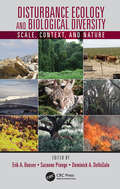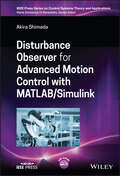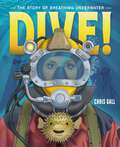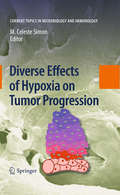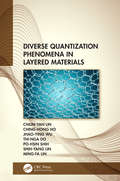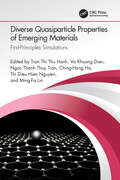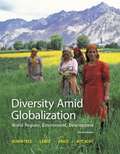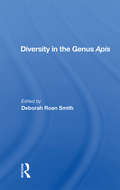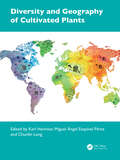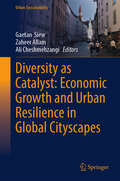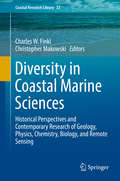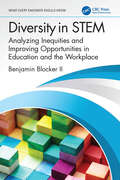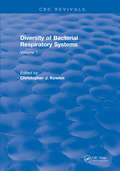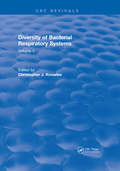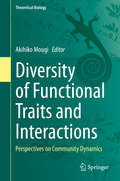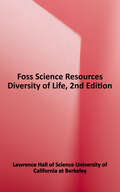- Table View
- List View
Disturbance Ecology and Biological Diversity: Context, Nature, and Scale
by Erik A. Beever Inger Suzanne Prange Dominick A. DellaSalaThis book presents cascading effects of ecological disturbances on a multitude of ecosystem components. It includes agricultural development, large infrequent disturbances, forest harvesting, non-native grazing in deserts, ground transportation, powerline corridors, fires, urban ecology, disturbance in aquatic ecosystems, land-use dynamics on diversity, habitat fragmentation, sedimentation of wetlands, and contemporary climate change. The book facilitates users in understanding why disturbances are occurring while recommending mitigation and remediation strategies.
Disturbance Observer for Advanced Motion Control with MATLAB / Simulink (IEEE Press Series on Control Systems Theory and Applications)
by Akira ShimadaDisturbance Observer for Advanced Motion Control with MATLAB/Simulink A fulsome and robust presentation of disturbance observers complete with MATLAB sample programs and simulation results In Disturbance Observer for Advanced Motion Control with MATLAB/Simulink, distinguished electronics engineer Dr. Akira Shimada delivers a comprehensive exploration of the suppression of actual and unknown disturbances. In the book, you’ll find a systematic discussion of the basic theory and design methods of disturbance observers accompanied by instructive MATLAB and Simulink simulation examples. Included appendices cover the mathematical background of classical, modern, and digital control and ground the reader’s understanding of the more advanced sections. The included material is ideal for students enrolled in courses in advanced motion control, mechatronics system control, electrical drives, motion control, robotics, and aeronautics. In addition to topics like model predictive control, vibration systems, acceleration control, adaptive observers, and multi-rate sampling, readers will find: A thorough introduction to the various types of disturbance observers and the fundamentals of disturbance observers, including disturbance estimation and disturbance rejection Comprehensive explorations of stabilized control and coprime factorization, including the derivation of stabilizing controllers Practical discussions of disturbance observers in state space, including identity input disturbance observers and identity reaction force observers Fulsome treatments of the mathematical foundations of control theory, methods??for measuring and estimating velocities, and the disturbance estimation Kalman filter Perfect for undergraduate and graduate students with existing knowledge of the fundamentals of control engineering who wish to learn how to design disturbance observers, Disturbance Observer for Advanced Motion Control with MATLAB/Simulink will also benefit professional engineers and researchers studying alternative control theories.
Disturbing the Solar System: Impacts, Close Encounters, and Coming Attractions
by Alan E. RubinThe solar system has always been a messy place in which gravity wreaks havoc. Moons form, asteroids and comets crash into planets, ice ages commence, and dinosaurs disappear. By describing the dramatic consequences of such disturbances, this authoritative and entertaining book reveals the fundamental interconnectedness of the solar system--and what it means for life on Earth. After relating a brief history of the solar system, Alan Rubin describes how astronomers determined our location in the Milky Way. He provides succinct and up-to-date accounts of the energetic interactions among planetary bodies, the generation of the Earth's magnetic field, the effects of other solar-system objects on our climate, the moon's genesis, the heating of asteroids, and the origin of the mysterious tektites. Along the way, Rubin introduces us to the individual scientists--including the famous, the now obscure, and the newest generation of researchers--who have enhanced our understanding of the galactic neighborhood. He shows how scientific discoveries are made; he discusses the uncertainty that presides over the boundaries of knowledge as well as the occasional reluctance of scientists to change their minds even when confronted by compelling evidence. This fresh historical perspective reveals science as it is: an imperfect but self-correcting enterprise. Journeying to the frontiers of knowledge, Rubin concludes with the exciting realm of astrobiology. He chronicles the history of the search for life on Mars and describes cutting-edge lines of astrobiological inquiry, including panspermia (the possible transfer of life from planet to planet), the likelihood of technologically advanced alien civilizations in our galaxy, and our probable responses to alien contact. Authoritative and up-to-date but also entertaining and fluidly written, Disturbing the Solar System will appeal to any reader who has ever picked up a rock or gazed at the moon with a sense of wonder.
Disturbing the Universe
by Freeman DysonWhile the focus of this book is a biography of the physicist Freeman Dyson up till about 1980, the side stories and range of people and projects he became involved in make this book a galaxy spanning story. From analyzing British bomber activity in WW II to meeting Hans Bethe and Richard Feynman when he was just trying to figure out what he wanted as a career, to helping design a nuclear starship to work on nuclear arms control, to the intersection of physics and biology, along with the poetry and stories that inspired him and the activities of his own family, the story expands to fill an amazing volume.
Dive!: The Story of Breathing Underwater
by Chris GallDIVE! is a fascinating introduction to the comprehensive world history of diving by award-winning artist Chris Gall.How do you breathe underwater? What tools can we use to go deeper and deeper into the oceans? And...what's down there?Two-thirds of our Earth is covered in ocean, yet only 5% of it has been explored. DIVE deep into our long history of sea exploration to learn why, how, and when humans have dived, and uncover our biggest questions about what hides in the Earth's deepest waters.Perfect for STEM-oriented minds and young and old readers fascinated by the sea, Dive! is a must-have to add to any nonfiction shelf.
Dive, Dolphin! (National Geographic Kids Readers)
by Shira EvansFrom the classic bottlenose dolphin to the orca, young readers will learn all about these amazing animals in this pre-reader. Through text features such as the vocabulary tree and the wrap-up activity, kids will be introduced to vocabulary in concept groups—helping them make connections between words and expand their understanding of the world.
Diverse Effects of Hypoxia on Tumor Progression
by M. Celeste SimonHypoxia, defined as reduced oxygen tension, is a common physiological phenomenon in both normal embryonic development and malignancy progression. Although severe hypoxia is generally toxic for both normal tissue and tumors, neoplastic cells gradually adapt to prolonged hypoxia though additional genetic and genomic changes with a net result that hypoxia promotes tumor progression and therapeutic resistance. Hypoxia promotes cancer progression by regulating various aspects of cancer biology, including radiotherapy resistance, metabolism, angiogenesis and invasion/migration
Diverse Hydrogen Sources for Biomass-derivatives Conversion: Reaction and Mechanism
by Zhibao HuoThe book covers advances in conversion of biomass and derivatives into useful chemicals and fuels. It describes our recent researches relating to the hydrogenation of biomass derivatives by diverse hydrogen sources such as water, isopropanol, gaseous hydrogen and NaBH4 as well as their interesting mechanism aspects. A wide range of biomass derivatives and some novel hydrogenation processes are involved in this book. Development strategies and challenges in future research are also discussed. This book will help readers to expand their knowledge of biomass and its derivatives conversion.
Diverse Quantization Phenomena in Layered Materials
by Shih-Yang Lin Ming-Fa Lin Chiun-Yan Lin Jhao-Ying Wu Ching-Hong Ho Thi-Nga Do Po-Hsin ShihThis monograph offers a comprehensive overview of diverse quantization phenomena in layered materials, covering current mainstream experimental and theoretical research studies, and presenting essential properties of layered materials along with a wealth of figures. This book illustrates commonly used synthesis methods of these 2D materials and compares the calculated results and experimental measurements, including novel features not yet reported. The book also discusses experimental measurements of magnetic quantization, theoretical modeling for studying systems and covers diversified magneto-electronic properties, magneto-optical selection rules, unusual quantum Hall conductivities, and single- and many-particle magneto-Coulomb excitations. Rich and unique behaviors are clearly revealed in few-layer graphene systems with distinct stacking configuration, stacking-modulated structures, silicon-doped lattices, bilayer silicene/germanene systems with the bottom-top and bottom-bottom buckling structures, monolayer and bilayer phosphorene systems, and quantum topological insulators. The generalized tight-binding model, the static and dynamic Kubo formulas, and the random-phase approximation are developed/modified to thoroughly explore the fundamental properties and propose the concise physical pictures. Different high-resolution experimental measurements are discussed in detail, and they are consistent with the theoretical predictions. Aimed at readers working in materials science, physics, and engineering this book should be useful for potential applications in energy storage, electronic devices, and optoelectronic devices.
Diverse Quasiparticle Properties of Emerging Materials: First-Principles Simulations
by Ming-Fa Lin Ngoc Thanh Thuy Tran Ching-Hong Ho Vo Khuong Dien Tran Thi Thu Hanh Thi Dieu Hien NguyenDiverse Quasiparticle Properties of Emerging Materials: First-Principles Simulations thoroughly explores the rich and unique quasiparticle properties of emergent materials through a VASP-based theoretical framework. Evaluations and analyses are conducted on the crystal symmetries, electronic energy spectra/wave functions, spatial charge densities, van Hove singularities, magnetic moments, spin configurations, optical absorption structures with/without excitonic effects, quantum transports, and atomic coherent oscillations. Key Features • Illustrates various quasiparticle phenomena, mainly covering orbital hybridizations and spin-up/spin-down configurations • Mainly focuses on electrons and holes, in which their methods and techniques could be generalized to other quasiparticles, such as phonons and photons • Considers such emerging materials as zigzag nanotubes, nanoribbons, germanene, plumbene, bismuth chalcogenide insulators • Includes a section on applications of these materials This book is aimed at professionals and researchers in materials science, physics, and physical chemistry, as well as upper-level students in these fields.
Diversity Amid Globalization: World Regions, Environment, Development
by Martin Lewis Marie Price William Wyckoff Les RowntreeStudents learn to think outside of the map Diversity Amid Globalization takes students on a journey into the connections and diversity between people and places-the contrasting regions of the world-within thematically organized regional chapters. With an arresting visual layout and new and updated content and maps throughout, the text maintains and strengthens its hallmark thematic organization and focus on globalization, while encouraging students to participate in the material using a number of stimulating, interactive learning tools.
Diversity In The Genus Apis
by Deborah Roan SmithThe honey bees were formerly seen as a small, static group comprising four species, whose behavior and ecology were simple variants on the patterns found in Apis mellifera. The picture now is one of a large, actively speciating group, reflecting in part the complex geological and biological influence of the Apis environment. Research on this diversity has benefitted from new techniques of DNA analysis applied to several long-standing problems in honey bee phylogenetics and that are reported in this volume. The behavior and ecology of the Apis species and populations are also more diverse and differentiated than previously recognized: Radically different orientation systems as expressed through dance language exist in various species. This study of Apis will be of great interest not only to biologists and apiculturalists but to anyone interested in systematics, genetics, and ethology. Our view of apis has changed radically in the past few years as a result of recent research on the Asian honeybee. The contributors to this book focus on systematics, genetics, behaviour and ecology to offer a synthesis for understanding this economically and scientifically important genus.
Diversity and Benefits of Microorganisms from the Tropics
by João Lucio de Azevedo Maria Carolina QuecineThis book addresses the diversity of tropical microorganisms and its applications in agriculture, renewable energy production and environmental protection. It covers several tropical habitats such as rain forests, mangroves, sea and river waters and describes how microorganisms isolated from these regions can be used to control insects and plant diseases, to improve sugar cane and biofuels production among other applications. The book also aims to bring researchers' attention to the potential of tropical microorganisms for biotechnological purposes, an area that is still far from being well explored.
Diversity and Biotechnology of Extremophilic Microorganisms from India (Microorganisms for Sustainability)
by Pradnya Pralhad Kanekar Sagar Pralhad KanekarThis authored book collates information on extremophilic microorganisms from around the world with special emphasis on India. The main focus of this book is to describe extreme environments as the habitats of these microorganisms, mechanisms of the extremophiles to cope up with the surrounding environment, new taxa created, their physiological properties, their biotechnological potential in the production of different biomolecules and biomaterials, and their role in sustainability. The concept of the book is to have comprehensive information on the diversity of microorganisms in one place. The purpose of the present book is to make aware young researchers of the attempts made so far to isolate these different microbes, inspire them to revisit the extreme environments, investigate their biodiversity using advanced molecular techniques and explore further their biotechnological potential. This book is of interest to post-graduate students, young researchers of India as well as other countries. It is useful reading material for researchers involved in environmental microbiology, microbial diversity, microbial systematics, microbial culture collections, molecular taxonomy, and microbial biotechnology.
Diversity and Disagreement: From Fundamental Biases to Ethical Interactions
by Edward T. Cokely Adam FeltzThis book details the discovery and exploration of one of the major scientific revelations that has emerged from the field of experimental philosophy—i.e., that heritable personality traits often predict philosophical diversity and disagreement, and may help explain fundamental philosophical biases. Adam Feltz and Edward T. Cokely provide historical and personal perspectives on this differential approach within experimental philosophy and discuss how theoretical considerations and insights have started to have practical impact on practice in risk communication, law, medicine, public policy, and engineering (e.g., science for informed decision making; the ethics of choice architecture and nudges). The main goal in this book is to provide a theoretical framework for understanding variation in fundamental philosophical intuitions and how that variation informs ethical interaction theory. This is an open access book.
Diversity and Geography of Cultivated Plants
by Chunlin Long Karl Hammer Esquivel Pérez, Miguel ÁngelThis book presents information on cultivated plants located within 12 different regions throughout the world. The content introduces cultural evolution and species richness in cultivated plants, considering domestication assessments, which make it possible to obtain a deeper insight into the diversity of these plants.Cultivated plants are evolutionary connected to man, human action for nature and culture is necessary to secure the basis for future existence of humanity. Cultivated plants are included in this compilation, plants are grown for food, food additives, fodder, medicine, fiber, seasoning or as green manure crops, shade trees or hedge shrubs. The large number of commodity groups characterize the number of interactions between man and plants.The aim of this book is to bring together an actualized list of cultivated plants. It was necessary to organize, store and analyze gathered data during the exploration and collection missions, as well as those resulting from the ethnobotanical, archaeological and genomics studies. The book presents essayistic introductions; short data on areas of distribution and cultivation areas; the use of the plant; the history and descent of the plant; and citations of common names as a part of the cultural evolution of mankind. Where necessary, the content explores "gene sources” as plants for different breeding purposes including resistance, quality, yield improvement and weeds.
Diversity as Catalyst: Economic Growth and Urban Resilience in Global Cityscapes (Urban Sustainability)
by Ali Cheshmehzangi Zaheer Allam Gaetan SiewIn an era where global cities emerge as pivotal hubs for economic growth and cultural fusion, this book presents an innovative approach to understanding and leveraging the rich tapestry of diversity in urban environments. This book delves into how cultural diversity acts not just as a social asset but as a key driver of economic prosperity and urban resilience. What sets this book apart is its multidisciplinary perspective, combining insights from urban planning, economics, social sciences, and sustainability studies. It offers a fresh lens through which the dynamics of global cities are viewed, analyzed, and understood, aligning closely with Sustainable Development Goal 11 – making cities inclusive, safe, resilient, and sustainable. The scope of the book is both broad and deep, covering topics from the economic impact of cultural diversity in urban centers to strategies for balancing cultural heritage with modern urban development. It's a must-read for academics, policy makers, urban planners, and anyone interested in the future of urban living. Key features and benefits: Offers a unique blend of theory and practice, providing actionable insights for harnessing cultural diversity in urban development. Includes case studies and examples from cities around the world, making it relevant to a global audience. Directly aligns with global policy agendas, particularly SDG 11, offering a strategic guide for policymakers and urban developers.
Diversity in Coastal Marine Sciences
by Charles W. Finkl Christopher MakowskiThis book integrates a wide range of subjects into a coherent purview of the status of coastal marine science. Designed for the professional or specialist in coastal science, oceanography, and related disciplines, this work will appeal to workers in multidisciplinary fields that strive for practical solutions to environmental problems in coastal marine settings around the world. Examples are drawn from many different geographic areas, including the Black Sea region. Subject areas covered include aspects of coastal marine geology, physics, chemistry, biology, and history. These subject areas were selected because they form the basis for integrative investigation of salient environmental problems or perspective solutions or interpretation of historical context.
Diversity in STEM: Analyzing Inequities and Improving Opportunities in Education and the Workplace (What Every Engineer Should Know)
by Benjamin Blocker IIDiversity in STEM: Analyzing Inequities and Improving Opportunities in Education and the Workplace offers a survey of diversity in the broad field of Science, Technology, Engineering, and Mathematics (STEM) and provides potential solutions to improve outcomes in education, industry, and society. Offering a U.S.-based point of view, but with globally applicable concepts around race, gender, culture, politics, and socioeconomics, the book identifies where issues around diversity in STEM exist, how they were created, and how these issues are being addressed in STEM education and the STEM workforce.Features: Identifies conditions and causes of inequities from a societal perspective. Offers guidelines and solutions to identify and address cultural gaps in STEM. Covers STEM initiatives implemented at the K-12, college, and vocational levels and how they are beginning to alter the STEM landscape. Illustrates the benefits of fostering and maintaining a diverse, equitable, and inclusive workforce. Explores best practices used by companies and organizations to recruit, support, and develop diverse talent and strategies to continually evolve. Guides and empowers STEM professionals to seek out organizations whose values are aligned with their own. Providing an analytical and constructively practical viewpoint, the authors offer readers across the sciences, engineering, and medicine, as well as policymakers, the opportunity to consider why diversity and equity in STEM matter and how to apply best practices that support inclusivity to ensure successful outcomes for individuals, organizations, and society.
Diversity of Bacterial Respiratory Systems: Volume 1
by Christopher J. KowlesIt is the aim of this book to present reviews on a wide range of aspects of bacterial respiratory systems. Because the on-going publication elsewhere of reviews on bacterial respiration, ablanket coverage of the field has not been attempted. Rather, a range of topics have been selected, either because they are of special current interest, they have not been reviewed recently, or they have never been reviewed.
Diversity of Bacterial Respiratory Systems: Volume 2
by Christopher J. KowlesIt is the aim of this book to present reviews on a wide range of aspects of bacterial respiratory systems. Because the on-going publication elsewhere of reviews on bacterial respiration, ablanket coverage of the field has not been attempted. Rather, a range of topics have been selected, either because they are of special current interest, they have not been reviewed recently, or they have never been reviewed.
Diversity of Functional Traits and Interactions: Perspectives on Community Dynamics (Theoretical Biology)
by Akihiko MougiThis book presents new theoretical perspectives on ecological community dynamics and in so doing casts fresh light on the enduring complexity–stability debate. Real ecological communities do not simply comprise diverse species and interactions, which respectively represented the nodes and links of the classic network theory. Rather, they are characterized by different types of complexity, and this book explains how this diversity of complexity is key to understanding the dynamics of ecological communities. It is shown how various properties in natural communities, such as life history, adaptation, density dependence, sex, interaction types, space, functional traits, and microbial processes, can dramatically increase the complexity in ecological communities. Furthermore, innovative methods are introduced that may be applied to cast light on very complex communities. With each chapter presenting the latest advances and approaches, the book sets the direction for future research on ecological community dynamics. It will be a “must read” for researchers and students in the field of ecology.
Diversity of Life
by Lawrence Hall of Science University of California at BerkeleyThis book contains the following chapters including Science Safety Rules, Glossary and Index: What Is Life, The Microscope, The Cell, Domains, Plants: The Vascular System, Plant Reproduction and Growth, Insects, Diversity of Life.
Diversity of Life Resources: Images, Data and Readings
by FOSS Middle School Curriculum Development TeamThe book presents the diversity of life with images and related data and readings.
